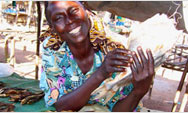You are here » Home » Telling Our Story
Success Story
Communities learn to protect their main resource — nature
Wildlife Conservancies Expand

| |
Photo: World Wildlife Fund
|
|
The Nyae Nyae Conservancy Steering Committee meeting in May 2004.
Community-based natural resource management is helping Namibia manage and protect its environment while empowering communities that live off the land.
|
In a positive development for both Namibians and the environment, Namibia formally registered 13 new conservancies in December 2005. With 44 official areas like this, the amount of land under conservancy management has increased to 40,546 square miles — almost 13 percent of Namibia’s total land area.
More than 70 percent of Namibians reside in rural areas and depend upon natural resources for their livelihoods. Now those residents can use, manage, and benefit from natural resources in a sustainable way. Conservancies help safeguard natural resources and protect wildlife, but they also create new economic opportunities and help develop local management skills. USAID has been the primary donor supporting the conservancy movement in Namibia for 13 years.
Namibia’s terrain is one of Africa’s driest and least fertile — this limits agricultural output and makes people dependent on natural resources for survival. Over the long term, it is critical to use those natural resources in a sustainable manner. Through conservancies, Namibians engage in community-based natural resource management forums and are learning techniques to protect their environment. Communities set up conservancy management committees that make decisions about protected lands.
USAID also works at the national level to help develop strategies to protect the environment. For instance, USAID is collaborating with the World Wildlife Fund to promote harmonization of national policies that help the government and local conservancies to successfully manage resources.
USAID’s efforts in the past decade have helped Namibia come a long way in protecting its environment — wildlife populations have increased and resources are less scarce. Conservancies are making a tremendous difference to the empowerment of local communities and are helping to combat poverty at the grassroots level.
Print-friendly version of this page (407kb - PDF)
Click here for high-res photo
Back to Top ^ | 

